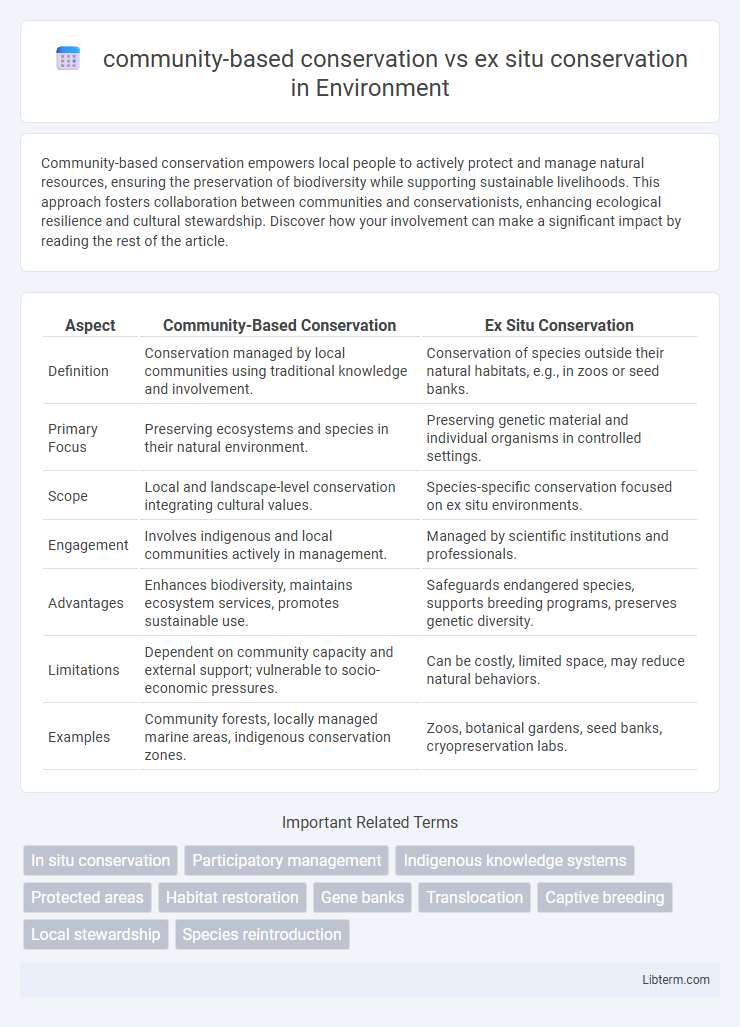Community-based conservation empowers local people to actively protect and manage natural resources, ensuring the preservation of biodiversity while supporting sustainable livelihoods. This approach fosters collaboration between communities and conservationists, enhancing ecological resilience and cultural stewardship. Discover how your involvement can make a significant impact by reading the rest of the article.
Table of Comparison
| Aspect | Community-Based Conservation | Ex Situ Conservation |
|---|---|---|
| Definition | Conservation managed by local communities using traditional knowledge and involvement. | Conservation of species outside their natural habitats, e.g., in zoos or seed banks. |
| Primary Focus | Preserving ecosystems and species in their natural environment. | Preserving genetic material and individual organisms in controlled settings. |
| Scope | Local and landscape-level conservation integrating cultural values. | Species-specific conservation focused on ex situ environments. |
| Engagement | Involves indigenous and local communities actively in management. | Managed by scientific institutions and professionals. |
| Advantages | Enhances biodiversity, maintains ecosystem services, promotes sustainable use. | Safeguards endangered species, supports breeding programs, preserves genetic diversity. |
| Limitations | Dependent on community capacity and external support; vulnerable to socio-economic pressures. | Can be costly, limited space, may reduce natural behaviors. |
| Examples | Community forests, locally managed marine areas, indigenous conservation zones. | Zoos, botanical gardens, seed banks, cryopreservation labs. |
Understanding Community-Based Conservation
Community-based conservation empowers local populations to manage natural resources sustainably, integrating traditional knowledge with modern practices to preserve biodiversity in situ. This approach fosters ecological resilience and cultural heritage by aligning conservation goals with community livelihoods and social structures. In contrast to ex situ conservation, which involves preserving species outside their natural habitats, community-based conservation maintains ecosystem functionality and species interactions within their native environments.
Exploring Ex Situ Conservation Strategies
Ex situ conservation strategies involve preserving species outside their natural habitats, often in controlled environments such as botanical gardens, seed banks, or zoos, ensuring genetic diversity and safeguarding endangered species. These methods complement in situ efforts by providing a backup population and opportunities for research, breeding, and reintroduction programs. Advances in cryopreservation and tissue culture further enhance the effectiveness of ex situ conservation, supporting long-term species survival amid habitat loss and climate change pressures.
Key Differences Between Community-Based and Ex Situ Approaches
Community-based conservation emphasizes protecting biodiversity through local community engagement, sustainable resource use, and traditional knowledge integration, fostering habitat preservation in natural environments. Ex situ conservation involves the preservation of species outside their natural habitats, such as in zoos, botanical gardens, or seed banks, focusing on species survival through controlled breeding and storage. While community-based conservation supports ecosystem balance and cultural values, ex situ methods provide a safeguard against extinction and genetic erosion for critically endangered species.
Benefits of Community Engagement in Conservation
Community-based conservation enhances biodiversity protection by actively involving local stakeholders who possess traditional ecological knowledge, leading to more sustainable and culturally appropriate management practices. Empowering communities fosters stewardship, ensuring long-term commitment and resilience against environmental threats. This approach also improves livelihood opportunities through eco-tourism and sustainable resource use, reinforcing the social and economic incentives to conserve natural habitats.
Challenges Faced by Ex Situ Conservation Initiatives
Ex situ conservation initiatives face significant challenges including high operational costs, genetic diversity loss, and limited adaptability to natural habitats. Maintaining viable populations outside their natural environments requires advanced technology and expertise, often unavailable in resource-limited regions. Furthermore, recreating intricate ecosystem interactions is difficult, reducing the overall effectiveness of ex situ efforts compared to community-based conservation approaches.
Role of Indigenous Knowledge in Community-Based Conservation
Indigenous knowledge plays a crucial role in community-based conservation by providing time-tested practices and ecological insights that promote sustainable resource management and biodiversity preservation. This knowledge encompasses traditional land-use methods, species identification, and spiritual connections to nature, enabling communities to maintain ecosystem balance effectively. In contrast to ex situ conservation, which involves preserving species outside their natural habitats, community-based conservation leverages indigenous expertise to protect and restore ecosystems in situ, fostering resilience and cultural heritage.
Genetic Diversity: On-Site vs. Off-Site Preservation
Community-based conservation preserves genetic diversity on-site by maintaining species within their natural habitats, allowing ongoing adaptation to local environmental conditions and ecosystem interactions. Ex situ conservation stores genetic material off-site in controlled environments such as seed banks, botanical gardens, or cryopreservation facilities, ensuring backup populations and protection from immediate threats. Balancing both approaches enhances overall genetic diversity preservation by integrating habitat-specific evolutionary processes with secure, long-term genetic repositories.
Cost-Effectiveness of Conservation Methods
Community-based conservation often proves more cost-effective than ex situ conservation by leveraging local knowledge and resources to manage ecosystems sustainably, reducing expenses associated with transportation and specialized facilities. Ex situ conservation requires significant financial investment for infrastructure, such as botanical gardens, seed banks, or captive breeding centers, and ongoing operational costs. Economically, integrating community-based approaches can enhance long-term conservation outcomes while minimizing the high costs inherent in maintaining species outside their natural habitats.
Integrating Community and Ex Situ Efforts for Biodiversity
Integrating community-based conservation with ex situ conservation efforts enhances biodiversity preservation by combining local knowledge and genetic resource safeguarding. Community involvement ensures sustainable habitat management and species protection, while ex situ methods like seed banks and captive breeding provide insurance populations against extinction. Synergizing these approaches maximizes conservation outcomes through habitat restoration, genetic diversity maintenance, and resilience to environmental changes.
Future Directions in Conservation Practices
Future directions in conservation practices increasingly emphasize community-based conservation, leveraging local knowledge and stakeholder engagement to enhance biodiversity outcomes and ensure sustainable resource management. Innovations in participatory monitoring and adaptive governance are being integrated to empower indigenous and local communities while addressing socio-economic challenges. In contrast, ex situ conservation continues to evolve through advanced biotechnologies and cryopreservation techniques to safeguard genetic diversity, complementing in situ efforts and providing critical reservoirs for potential species reintroductions.
community-based conservation Infographic

 libterm.com
libterm.com